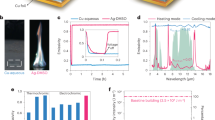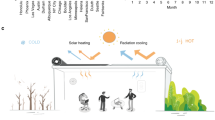Abstract
Current efforts to improve building envelopes mostly focus on reducing energy demand by static measures such as insulation, selective glazing and shading. The resulting envelopes are limited in adapting to weather conditions or occupants’ needs and leave vast potentials for energy savings, onsite energy generation and improvement of occupant comfort untapped. In this work, we report on a dynamic building envelope that utilizes lightweight modules based on a hybrid hard/soft-material actuator to actively modulate solar radiation for local energy generation, passive heating, shading and daylight penetration. We describe two envelope prototypes and demonstrate autonomous solar tracking in real weather conditions. The dynamic photovoltaic envelope achieves an increase of up to 50% in electricity gains as compared to a static photovoltaic envelope. We assess energy savings potentials for three locations, six construction periods and two building use types. The envelope is most effective in temperate and arid climates, in which, for the cases analyzed, it can provide up to 115% of the net energy demand of an office room.
This is a preview of subscription content, access via your institution
Access options
Access Nature and 54 other Nature Portfolio journals
Get Nature+, our best-value online-access subscription
$29.99 / 30 days
cancel any time
Subscribe to this journal
Receive 12 digital issues and online access to articles
$119.00 per year
only $9.92 per issue
Buy this article
- Purchase on Springer Link
- Instant access to full article PDF
Prices may be subject to local taxes which are calculated during checkout







Similar content being viewed by others
Data availability
The data that support the plots within this paper are partly available on a public repository (https://github.com/architecture-building-systems/CityEnergyAnalyst)51 or from the corresponding author upon reasonable request.
Change history
22 July 2019
An amendment to this paper has been published and can be accessed via a link at the top of the paper.
References
Lucon, O. et al. in Climate Change 2014: Mitigation of Climate Change (eds Edenhofer, O. et al.) Ch. 9 (IPCC, Cambridge Univ. Press, 2014).
Tracking Progress: Building Envelopes (International Energy Agency, 2017).
Kammen, D. M. & Sunter, D. A. City-integrated renewable energy for urban sustainability. Science 352, 922–928 (2016).
Mathiesen, B. V., Lund, H. & Karlsson, K. 100% renewable energy systems, climate mitigation and economic growth. Appl. Energy 88, 488–501 (2011).
Rogelj, J. et al. Energy system transformations for limiting end-of-century warming to below 1.5 °C. Nat. Clim. Change 5, 519–527 (2015).
Directive 2010/31/EU of the European Parliament and of the Council of 19 May 2010 on the energy performance of buildings (recast) Off. J. Eur. Union 18, 2010 (2010).
Loonen, R. C. G. M., Trčka, M., Cóstola, D. & Hensen, J. L. M. Climate adaptive building shells: state-of-the-art and future challenges. Renew. Sustain. Energy Rev. 25, 483–493 (2013).
Linn, C. Kinetic Architecture: Design for Active Envelopes (Images Publishing, 2014).
Trivedi, D., Rahn, C. D., Kier, W. M. & Walker, I. D. Soft robotics: biological inspiration, state of the art, and future research. Appl. Bionics Biomech. 5, 99–117 (2008).
Majidi, C. Soft robotics: a perspective—current trends and prospects for the future. Soft Robotics 1, 5–11 (2014).
Ilievski, F., Mazzeo, A. D., Shepherd, R. F., Chen, X. & Whitesides, G. M. Soft robotics for chemists. Angew. Chem. Int. Ed. 50, 1890–1895 (2011).
Wang, L. et al. Soft-material robotics. Found. Trends Robotics 5, 191–259 (2017).
Tolley, M. T. et al. A resilient, untethered soft robot. Soft Robotics 1, 213–223 (2014).
Mosadegh, B. et al. Pneumatic networks for soft robotics that actuate rapidly. Adv. Funct. Mater. 24, 2163–2170 (2014).
Trimmer, B. A practical approach to soft actuation. Soft Robotics 4, 1–2 (2017).
Deimel, R. & Brock, O. A novel type of compliant and underactuated robotic hand for dexterous grasping. Int. J. Robotics Res. 35, 161–185 (2016).
Asbeck, A. T., Dyer, R. J., Larusson, A. F. & Walsh, C. J. Biologically-inspired soft exosuit. In 2013 IEEE 13th International Conference on Rehabilitation Robotics 1–8 (2013).
Cianchetti, M. et al. Soft robotics technologies to address shortcomings in today’s minimally invasive surgery: the STIFF-FLOP approach. Soft Robotics 1, 122–131 (2014).
Bartlett, N. W. et al. A 3D-printed, functionally graded soft robot powered by combustion. Science 349, 161–165 (2015).
Wehner, M. et al. An integrated design and fabrication strategy for entirely soft, autonomous robots. Nature 536, 451–455 (2016).
Rus, D. & Tolley, M. T. Design, fabrication and control of soft robots. Nature 521, 467–475 (2015).
Block, P. et al. NEST HiLo: investigating lightweight construction and adaptive energy systems. J. Build. Eng. 12, 332–341 (2017).
Nagy, Z. et al. The adaptive solar facade: from concept to prototypes. Front. Archit. Res. 5, 143–156 (2016).
Jayathissa, P. et al. Optimising building net energy demand with dynamic BIPV shading. Appl. Energy 202, 726–735 (2017).
Jayathissa, P., Zarb, J., Luzzatto, M., Hofer, J. & Schlueter, A. Sensitivity of building properties and use types for the application of adaptive photovoltaic shading systems. Energy Procedia 122, 139–144 (2017).
Jayathissa, P., Caranovic, S., Hofer, J., Nagy, Z. & Schlueter, A. Performative design environment for kinetic photovoltaic architecture. Autom. Constr. 93, 339–347 (2018).
Mousazadeh, H. et al. A review of principle and sun-tracking methods for maximizing solar systems output. Renew. Sustain. Energy Rev. 13, 1800–1818 (2009).
Rossi, D., Nagy, Z. & Schlueter, A. Adaptive distributed robotics for environmental performance, occupant comfort and architectural expression. Int. J. Archit. Comput. 10, 341–359 (2012).
Powell, D., Hischier, I., Jayathissa, P., Svetozarevic, B. & Schlüter, A. A reflective adaptive solar façade for multi-building energy and comfort management. Energy Build. 177, 303–315 (2018).
Kim, J. T. & Kim, G. Overview and new developments in optical daylighting systems for building a healthy indoor environment. Build. Environ. 45, 256–269 (2010).
Chow, T. T. A review on photovoltaic/thermal hybrid solar technology. Appl. Energy 87, 365–379 (2010).
Chemisana, D. Building integrated concentrating photovoltaics: a review. Renew. Sustain. Energy Rev. 15, 603–611 (2011).
Ullah, I. & Shin, S. Highly concentrated optical fiber-based daylighting systems for multi-floor office buildings. Energy Build. 72, 246–261 (2014).
Georgescu, M., Morefield, P. E., Bierwagen, B. G. & Weaver, C. P. Urban adaptation can roll back warming of emerging megapolitan regions. Proc. Natl Acad. Sci. USA 111, 2909–2914 (2014).
Santamouris, M. Cooling the cities – a review of reflective and green roof mitigation technologies to fight heat island and improve comfort in urban environments. Sol. Energy 103, 682–703 (2014).
Rossi, F. et al. Retroreflective façades for urban heat island mitigation: experimental investigation and energy evaluations. Appl. Energy 145, 8–20 (2015).
Manti, M., Cacucciolo, V. & Cianchetti, M. Stiffening in soft robotics: a review of the state of the art. IEEE Robot. Autom. Mag 23, 93–106 (2016).
Stilli, A., Wurdemann, H. A. & Althoefer, K. Shrinkable, stiffness-controllable soft manipulator based on a bio-inspired antagonistic actuation principle. In Proc IEEE/RSJ International Conference on Intelligent Robots and Systems (Ed. Parker, L.) 2476–2481 (IEEE, 2014).
Vanderborght, B. et al. Variable impedance actuators: a review. Robotics Auton. Syst. 61, 1601–1614 (2013).
Pfeifer, R., Lungarella, M. & Iida, F. Self-organization, embodiment, and biologically inspired robotics. Science 318, 1088–1093 (2007).
Nagy, Z., Yong, F. Y., Frei, M. & Schlueter, A. Occupant centered lighting control for comfort and energy efficient building operation. Energy Build. 94, 100–108 (2015).
Hofer, J., Groenewolt, A., Jayathissa, P., Nagy, Z. & Schlueter, A. Parametric analysis and systems design of dynamic photovoltaic shading modules. Energy Sci. Eng. 4, 134–152 (2016).
Luthander, R., Widén, J., Nilsson, D. & Palm, J. Photovoltaic self-consumption in buildings: review. Appl. Energy 142, 80–94 (2015).
Lydon, G. P., Hofer, J., Svetozarevic, B., Nagy, Z. & Schlueter, A. Coupling energy systems with lightweight structures for a net plus energy building. Appl. Energy 189, 310–326 (2017).
Zhao, H., Li, Y., Elsamadisi, A. & Shepherd, R. Scalable manufacturing of high force wearable soft actuators. Extreme Mech. Lett. 3, 89–104 (2015).
Galloway, K. C. et al. Soft robotic grippers for biological sampling on deep reefs. Soft Robotics 3, 23–33 (2016).
Moseley, P. et al. Modeling, design, and development of soft pneumatic actuators with finite element method. Adv. Eng. Mater. 18, 978–988 (2016).
Jayathissa, P. et al. Structural and architectural integration of adaptive photovoltaic modules. In Proc 11th Conference on Advanced Building Skins C6–3 (Advanced Building Skins GmbH, 2016).
Fonseca, J. A., Nguyen, T.-A., Schlueter, A. & Marechal, F. City energy analyst (CEA): integrated framework for analysis and optimization of building energy systems in neighborhoods and city districts. Energy Build. 113, 202–226 (2016).
City Energy Analyst (accessed 22 March 2019); https://cityenergyanalyst.com/
City Energy Analyst Version 2.9.0 (GitHub, accessed 22 March 2019); https://github.com/architecture-building-systems/CityEnergyAnalyst
Acknowledgements
We thank G. Lydon from the Architecture and Building Systems Group, ETH Zurich, for helpful suggestions. We thank M. Niffeler from the Architecture and Building Systems Group, ETH Zurich, for assistance with FEA. We acknowledge support from the Building Technologies Accelerator programme of Climate-KIC. We acknowledge Flisom AG for provision of high-efficiency CIGS PV modules.
Author information
Authors and Affiliations
Contributions
B.S. and M.B. developed the soft actuator and quick-cast fabrication process. M.B. fabricated soft actuators. S.C. and P.J. developed the rod–net facade supporting structure. B.S. and S.C. developed the pneumatic control systems. B.S. developed control algorithms. B.S. performed the experiments. P.J. performed the simulations. B.S., P.J. and M.B. constructed the dynamic facade with 16 modules. S.C., P.J., M.B. and B.S. constructed the dynamic facade with 30 modules. A.S., Z.N., J.H., I.H. and R.F.S. supervised the project. B.S. and A.S. wrote the paper. All authors discussed the results and commented on the manuscript.
Corresponding author
Ethics declarations
Competing interests
B.S., M.B., P.J., S.C. and A.S. are inventors on an international patent application (PCT/EP2018/080425) submitted by ETH Zurich that covers the actuator, the manufacturing method, the pneumatic control system and the envelope. The remaining authors declare no competing interests.
Additional information
Publisher’s note: Springer Nature remains neutral with regard to jurisdictional claims in published maps and institutional affiliations.
Supplementary information
Supplementary Information
Supplementary Figs. 1–10, Notes 1–3, Table 1 and refs.
Supplementary Video 1
The video shows the operation of the soft-robotic-driven dynamic building envelope with 30 elements. The envelope cycles through different states, such as open, close, towards east and towards west. Parallel and sequential control of envelope rows is also presented, demonstrating the possibility to generate different transition patterns. The envelope is mounted at the NEST building at the Swiss Federal Laboratories for Materials Science and Technology, in Dübendorf, Switzerland.
Rights and permissions
About this article
Cite this article
Svetozarevic, B., Begle, M., Jayathissa, P. et al. Dynamic photovoltaic building envelopes for adaptive energy and comfort management. Nat Energy 4, 671–682 (2019). https://doi.org/10.1038/s41560-019-0424-0
Received:
Accepted:
Published:
Issue Date:
DOI: https://doi.org/10.1038/s41560-019-0424-0
This article is cited by
-
Implementation of parametric modeling to design Miura origami-inspired canopy toward adaptive urban habitat
Architecture, Structures and Construction (2024)
-
High-performance wood-based thermoelectric sponges for thermal energy harvesting and smart buildings
Nano Research (2024)
-
Performative driven form finding in the early design stage
Journal of Engineering and Applied Science (2023)
-
Self-recovering passive cooling utilizing endothermic reaction of NH4NO3/H2O driven by water sorption for photovoltaic cell
Nature Communications (2023)
-
Artificial intelligence for structural glass engineering applications — overview, case studies and future potentials
Glass Structures & Engineering (2020)



